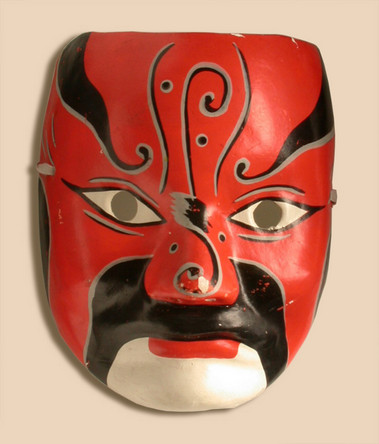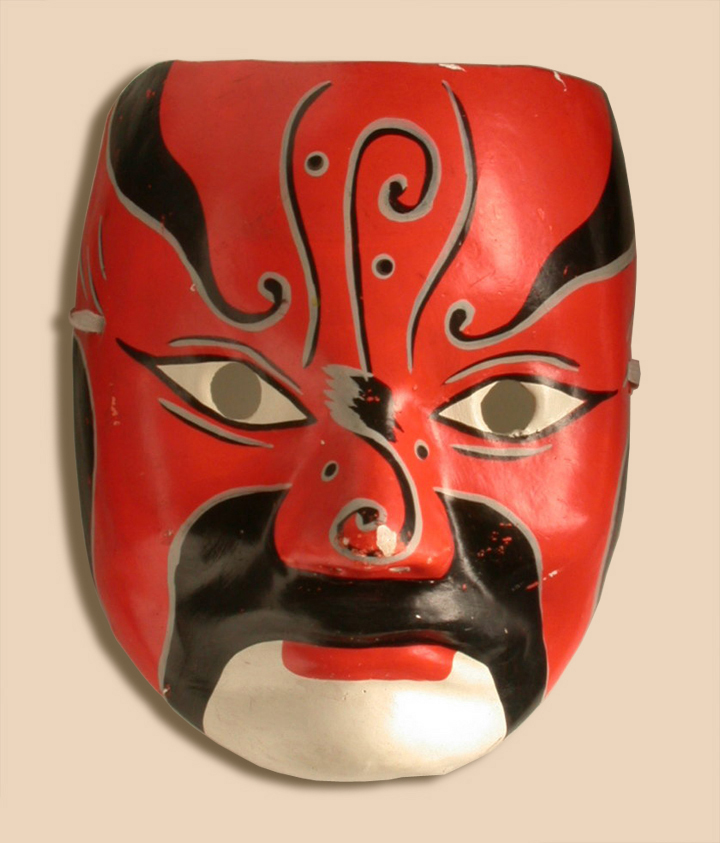Opera Mask, China
Masks were worn by characters in Chinese Opera hundreds of years ago. However, this mask is modern and was probably made as a souvenir. Nowadays, masks are not worn in Chinese Opera but bright make-up is used instead.
This light wooden mask is made to fit snugly over the wearer's face. Elastic threaded through two holes at either side of the mask goes behind the wearer's head to hold it in place. Colours have symbolic meaning in Chinese Opera, for example, red shows that the character is brave and loyal, while black is used for a honest person. This mask is red and black and so we think it is likely to be that of a warrior jing (painted face) because, in the opera tradition, warriors are considered to be courageous, loyal and forthright. Jing characters play a supporting male role and are usually warriors, statesman or demons.
This light wooden mask is made to fit snugly over the wearer's face. Elastic threaded through two holes at either side of the mask goes behind the wearer's head to hold it in place. Colours have symbolic meaning in Chinese Opera, for example, red shows that the character is brave and loyal, while black is used for a honest person. This mask is red and black and so we think it is likely to be that of a warrior jing (painted face) because, in the opera tradition, warriors are considered to be courageous, loyal and forthright. Jing characters play a supporting male role and are usually warriors, statesman or demons.

Length:17cm
Chinese Opera, a performance of music, dance, martial arts and acrobatics, began over two thousand years ago. Since then, over 360 varieties of opera have developed across the country. China is a huge country, divided into provinces with many different peoples and languages. Each area has its own opera where the music is unique and the songs are sung in the local language. For example, Cantonese Opera comes from Canton province. Beijing Opera is perhaps the best known of the Chinese Operas. The music is quite different from European operas and its purpose is to punctuate the action in the drama. High-pitched voices pierce the air, accompanied by crashing cymbals, banging gongs and drums and the sounds of stringed instruments such as fiddles and mandolins. The story-lines are often from historical epics and traditional romantic stories - heroes battle against powerful demons, good triumphs over evil and the heroine is saved from disaster.
There are four main types of character in Chinese Opera: heroes (sheng); heroines (dan); clowns (chou); and painted faces (jing). The actors in the Chinese Opera carry props and wear elaborate costumes, make-up and head-dress to take on a character's role. They used to wear masks, but nowadays jing and chou characters have their faces painted with brightly coloured make-up. The actors are literally wearing their emotions on their faces. These painted faces provide what the Chinese call a mirror to the soul which enables the audience to identify each character.
In Chinese Opera there are many variations on the face designs - over a thousand have been counted. Face make-ups are considered to be a special art and appear in ornamental designs and Chinese paintings as well as in opera performances. Colours and designs show the character's age, occupation and personality. In Chinese Opera, each colour symbolises a different characteristic. Green represents a stubborn and violent character; white is for a cunning and deceitful character; gold and silver show that a character is a god or demon; purple is for wisdom; yellow is for fierceness; and grey is for an old scoundrel. Red means that the character is brave and loyal, while black illustrates a rough and honest nature. This mask is red and black. It is likely that this is the mask of a warrior jing because in the opera tradition, warriors are considered to be courageous, loyal and forthright.
There are four main types of character in Chinese Opera: heroes (sheng); heroines (dan); clowns (chou); and painted faces (jing). The actors in the Chinese Opera carry props and wear elaborate costumes, make-up and head-dress to take on a character's role. They used to wear masks, but nowadays jing and chou characters have their faces painted with brightly coloured make-up. The actors are literally wearing their emotions on their faces. These painted faces provide what the Chinese call a mirror to the soul which enables the audience to identify each character.
In Chinese Opera there are many variations on the face designs - over a thousand have been counted. Face make-ups are considered to be a special art and appear in ornamental designs and Chinese paintings as well as in opera performances. Colours and designs show the character's age, occupation and personality. In Chinese Opera, each colour symbolises a different characteristic. Green represents a stubborn and violent character; white is for a cunning and deceitful character; gold and silver show that a character is a god or demon; purple is for wisdom; yellow is for fierceness; and grey is for an old scoundrel. Red means that the character is brave and loyal, while black illustrates a rough and honest nature. This mask is red and black. It is likely that this is the mask of a warrior jing because in the opera tradition, warriors are considered to be courageous, loyal and forthright.

Length:17cm

Masks were worn by characters in Chinese Opera hundreds of years ago. However, this mask is modern and was probably made as a souvenir. Nowadays, masks are not worn in Chinese Opera but bright make-up is used instead.
This light wooden mask is made to fit snugly over the wearer's face. Elastic threaded through two holes at either side of the mask goes behind the wearer's head to hold it in place. Colours have symbolic meaning in Chinese Opera, for example, red shows that the character is brave and loyal, while black is used for a honest person. This mask is red and black and so we think it is likely to be that of a warrior jing (painted face) because, in the opera tradition, warriors are considered to be courageous, loyal and forthright. Jing characters play a supporting male role and are usually warriors, statesman or demons.
This light wooden mask is made to fit snugly over the wearer's face. Elastic threaded through two holes at either side of the mask goes behind the wearer's head to hold it in place. Colours have symbolic meaning in Chinese Opera, for example, red shows that the character is brave and loyal, while black is used for a honest person. This mask is red and black and so we think it is likely to be that of a warrior jing (painted face) because, in the opera tradition, warriors are considered to be courageous, loyal and forthright. Jing characters play a supporting male role and are usually warriors, statesman or demons.
- Term:
- Description:
- Chou
- The clown character in Chinese Opera. He usually has a patch of white on his nose.
- Dan
- The heroine in Chinese Opera.
- Jing
- The painted face character in Chinese Opera. This character used to wear a mask but nowadays it has a painted face instead.
- Opera
- A musical drama.
- Provinces
- Province - the division of a country into separate districts.
- Sheng
- The hero in Chinese Opera.
- Souvenir
- A keepsake or memento, something that reminds a person of an event or place. Often, tourists buy souvenirs.
- Warrior
- A fighter in a war.




















